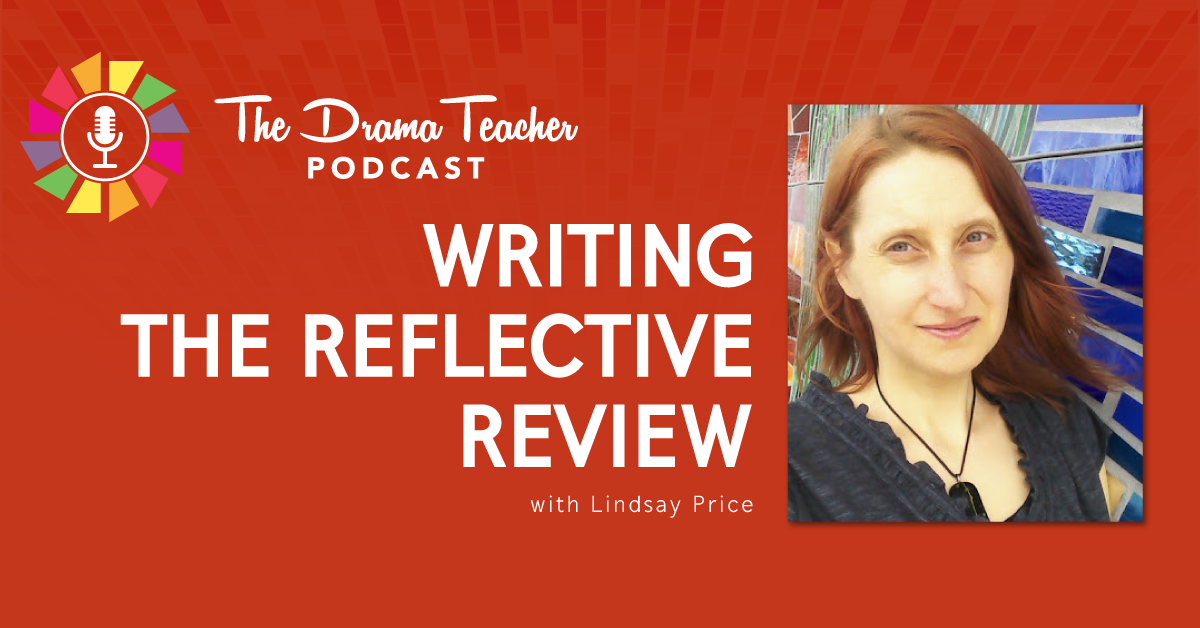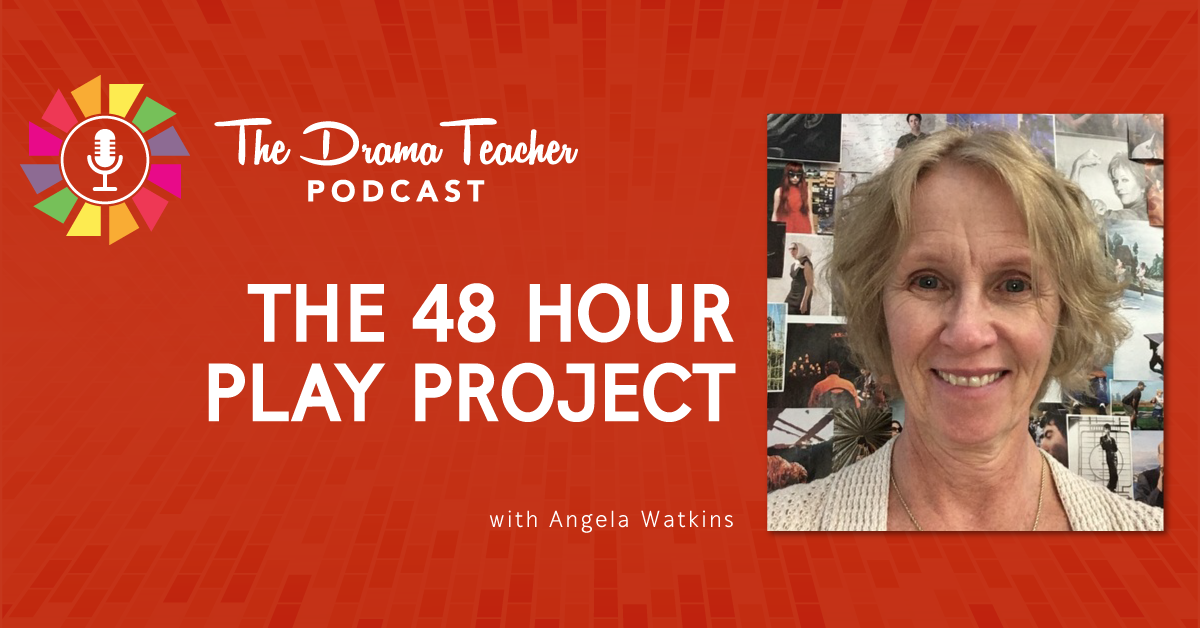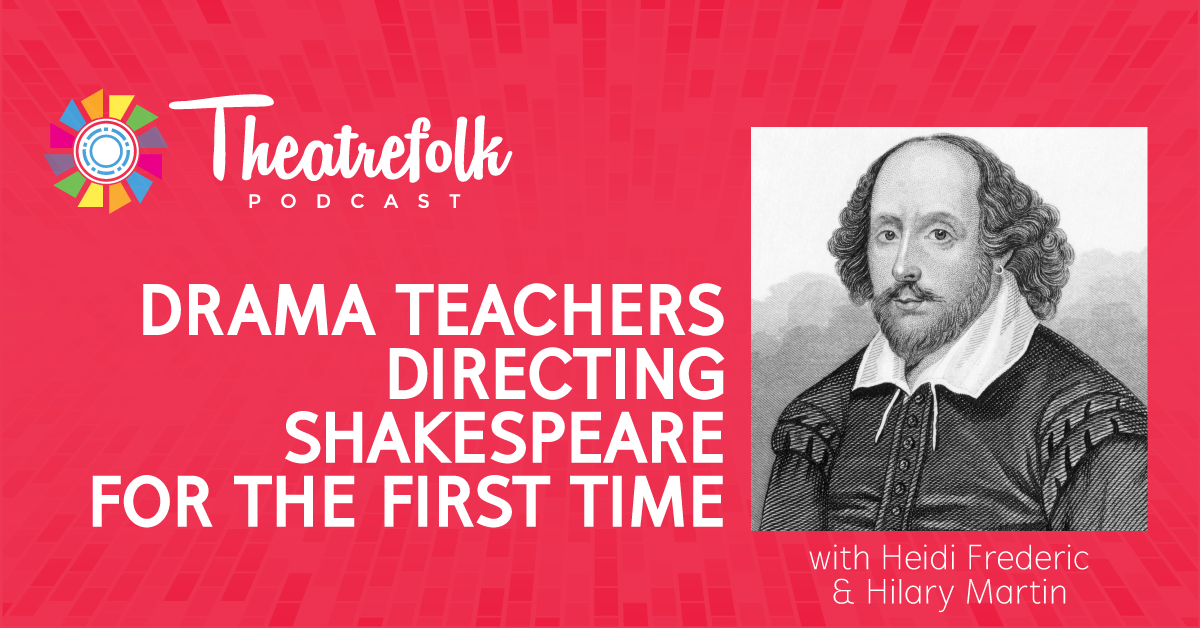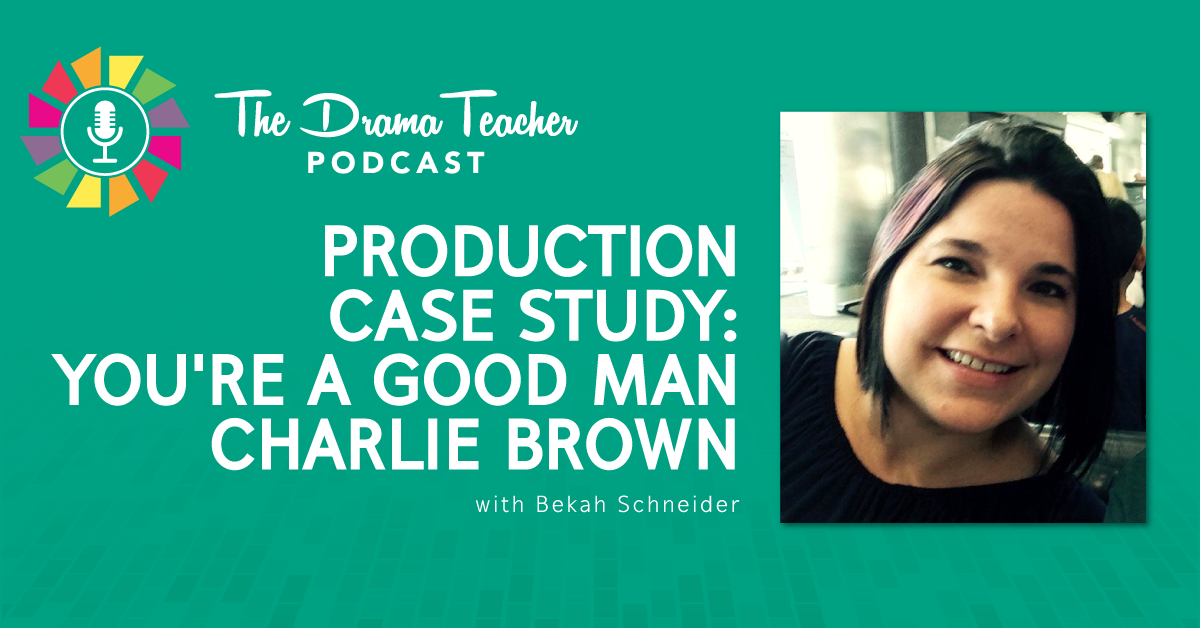Writing the Reflective Review
Episode 120: Writing the Reflective Review
Do you tear your hair out when students write play reviews? “It was good…it was ok….it sucked.” Writing an objective and reflective review is tricky because going to the theatre is a subjective experience. If you hate a play, how can you write about it objectively? Craig and Lindsay discuss a method to do just that – writing the reflective review. Use it in your classroom!
Show Notes
Episode Transcript
Welcome to TFP – The Theatrefolk Podcast – the place to be for Drama teachers, Drama students, and theatre educators everywhere.
I’m Lindsay Price, resident playwright for Theatrefolk.
Hello, I hope you’re well. Thanks for listening.
Welcome to Episode 120! You can find any links for this episode at the show notes at theatrefolk.com/episode120.
Okay. So, some of my favorite podcasts are the ones where Craig and I get to discuss theatre – we get to talk shop – and sometimes we agree and sometimes we disagree, but it’s fun! It’s fun to talk about the thing that we do and the plays that we’ve seen and it’s good for the brain cells!
So, last month, we were in New York and we got to talk a lot of theatre because we saw a lot of theatre – some of which we didn’t like at all – and that led to this specific podcast. How do you review something that you don’t like? How do you review it reflectively, in an objective manner? How do you teach a student to review something that they don’t know how to articulate, right? It’s so key for student reviewers.
We’ve identified a process that we use with a play and that you can use in your classroom. Let’s get to it.
Lindsay: Okay. So, hello everyone! Today, on the podcast, we are talking about reviewing – the act or reviewing, how you can encourage your students to review in a reflective and an in-depth way so that they’re not just saying, “I liked this play. I didn’t like this play. I thought this play sucked.” We’ve got to get them to go further than that, right? If you’re not doing reviews with your students, I think it’s an excellent exercise, you know? If you have a drama club that’s putting on a play, have your classrooms come to see the play and write a review. I think it’s a great analysis exercises. So, Craig and I… Hello, Craig.
Craig: Hello, Lindsay.
Lindsay: We were in New York last month and we saw a number of plays – one of them that we didn’t like at all, right?
Craig: Yes, and I mean, we can’t just say “I didn’t like it.”
Lindsay: No. Well, I wanted to set that up because now what we’re going to do is we’re going to go through the process of reviewing the show and we’re going to go beyond that. We’re going to go beyond the simple gut reaction that we had to this show and write an effective review. Are you up for it?
Craig: I’m up for it.
Lindsay: Okay. So, there’s a couple of steps that we want to take. The first thing is, what is the show? So, Craig, what was the show that we saw?
Craig: The first show we’re going to talk about is a production of Tempest. The Shakespeare play is called The Tempest and this was called Tempest.
Lindsay: Okay. So, the first thing that you really want to do is you want to start gathering clues, right? “What is the production trying to achieve?” is the question that, as a reviewer, you have to start with. This usually is going to happen before you even see the play.
Craig: Yes. Luckily, in our case, we have their website and their marketing materials that tell us what it is they’re attempting to accomplish in the show. So, for this particular show, it says on their website, “Internationally renowned director Karin Coonrod and Obie-award winning composer Elizabeth Swados bring their significant craft, daring, and imagination to Shakespeare’s The Tempest in a world-premiere music-theatre production at La MaMa.” I’ll stop here. La MaMa is a very well-respected and well-renowned alternative theatre.
Lindsay: Experimental theatre, right? They’re supposed to be, I guess, turning things upside down.
Craig: Yeah, and then it talks about the cast.
Lindsay: That’s something that we need to know.
Craig: So, it’s a music theatre production. It’s a whole new adaptation and look at The Tempest, and they’ve even changed the name to Tempest.
Lindsay: Yes, I think that’s really key, you know. If you’ve got something that’s well-known and it’s got a new name, okay, we’re supposed to be looking at something new. There are three words there that they’re describing their styles, isn’t it?
Craig: “Craft, daring, and imagination.”
Lindsay: So, that’s a bit of a setup, right? If they’re putting that in their marketing materials, that’s what I’m expecting.
Craig: That’s what I’m expecting to see, for sure.
So, we walked into the theatre and it was set up as one big long thrust and we really thought it was cool. I thought it was very interesting because it reminded me of what I would expect to see in 8a Shakespearean theatre – the court theatres, right? Is that what they were called?
Lindsay: Yeah, yes.
Craig: So, Shakespeare, everyone thinks he performed at the globe; he actually performed in kind of two theatres. There was also an indoor venue called the Blackfriars. This reminded me of how it would be set up there. It’s basically one long thrust and the audience sat on three sides of the thrust.
Lindsay: And there was a huge pendulum, I think. It was sort of a globe that was set up and the very first thing they did when the show started was that someone came out and pushed the pendulum and lights came on and the entire audience ooh’d because it really was a little bit of theatricality.
Craig: Mm-hmm. The pendulum was lit from within and it had holes poked all through it so, when it was in motion, it was putting this dazzling kind of light show all over the theatre. It was quite effective because the play starts with a storm so your first challenge as a director of this play is how are you going to stage a storm at sea with a ship being wrecked on-stage and I thought this was a very effective way of starting the show. I was riveted at this point.
Lindsay: And this is what I expected. This is the kind of thing I expected from looking at the materials and sitting in the theatre. That’s exactly what I expected. And then, things changed, and it’s really important particularly to tell your students that, if they’re seeing something that they don’t like, you have to be even more particular and you have to be even more specific about what it is and you have to start documenting.
So, the next question to ask is, “How does the production go about achieving their goals?” What are they trying to achieve? They’re trying to achieve something new, right? This production of The Tempest changed the name and they’re very specific about saying that this is going to have craft and imagination.
Craig: And it’s a musical.
Lindsay: Yeah, that’s right. It’s taking the Shakespearean to a new level because it has a musical form.
So, what you want to do is you want to start looking at how does it go about achieving these goals? Is there imagination? Well, that opening had a lot of imagination, right?
Craig: Mm-hmm.
Lindsay: Yes. The first thing that happens in this play is that there is a huge storm. Then, afterwards, Prospero, the main character, tells a very, very long story.
Craig: Yes, it’s actually not the greatest bit of writing on Shakespeare’s part because it’s all exposition. It’s this long multipage story about how it is that Prospero and his daughter Miranda came to be on this island. They’ve been stuck on this island for many years. In any production of The Tempest that I’ve been involved with or I have seen, there is also an attempt to tell the story non-verbally – sometimes there’s a dumb show, sometimes there’s a video – because there’s a lot of text that we’re going through. My expectations for this show were that that part was going to be done in a song or a musical number because this is a musical. My expectations were also that it would be told in a visual and engaging way because this is an experimental theatre and I expected to see some sort of interesting staging.
Lindsay: Something that used the imagination.
Craig: Mm-hmm. And my first clue that this production was going to fall short was in this particular section because the entire bit was just statically told as dialogue – the same experience one would have if they read it in the script and listened to it in their heads.
Lindsay: So, we go on, what is the production trying to achieve? It’s trying to achieve a musical theatre production, it’s trying to achieve something new, and it’s trying to achieve something with the imagination. Let’s go with those three. Was it new? No. Did they try to do this moment with musical theatre? No. Did have any imagination? No.
So, that’s what you want to get. Instead of saying, “Oh, this moment was so boring!” you have your students identify what is the production trying to achieve and then apply it. How does it go about achieving it? Are they achieving it?
Here, in this first bit, the answer is no.
Craig: No.
Lindsay: So, let’s talk about something that was new and that is the approach of Ariel in this production. The character of Ariel is usually a sprite and it’s usually played with a lot of physical movement, with a lot of other-worldly costuming, with a lot of imagination and play because he’s not human – he’s not a real person.
Craig: No.
Lindsay: This part was played by a Broadway actor, a young actor. He was the lead in Billy Elliot and the way that he was directed and the way that it was staged is that this actor played the character of Ariel as if he was Billy Elliot.
Craig: Mm-hmm. Every line he gave was accompanied with a ballet move.
Lindsay: Or very much a Broadway musical theatre move.
Craig: Mm-hmm. And it was very much against the style of everything that had come before his entrance. That’s another thing I’d like to address in this show – every single grouping of character just had a completely different style of performance.
Lindsay: Like they were all in different plays.
Craig: Mm-hmm. I wanted to believe that this was an intentional thing from the director. If it wasn’t, that’s not a good thing because everything in the play should be intentional.
Lindsay: That goes into question three so don’t get too much into it.
Craig: Okay, sure.
Lindsay: Oh, that’s a little teaser for everybody listening.
Craig: Okay.
Lindsay: But we were very confused because he wasn’t dressed as Ariel is usually dressed and he didn’t act the way that Ariel usually acts. Okay. So, are they doing something new with this character? The answer is yes, and we’re going to leave it at that. It’s not whether or not we like it or we don’t like it. Is it addressing what the production is trying to achieve? We have to say yes because he’s different. We kind of think that the production was trying to purposely ground Ariel and sort of force him to be human because, at the end, took off all his worldly human clothes but he didn’t do anything different. He just walked off-stage.
Now, let’s talk about the music. So, it’s a musical theatre production.
Craig: Can I address that?
Lindsay: You betcha!
Craig: Okay. What I would love to address about this is that, in the play – the original play, The Tempest – there are several songs – maybe four or five songs, with maybe one or two very tiny exceptions, those were the only songs that were in the show. It was a great deal of a long time. We were very deep into the show before we first heard our first song, and this is supposed to be a musical theatre adaptation. And so, what confused me with this production was what was different about the music in this show than there would be in any other show because there is music in The Tempest; it’s a play that’s very magical, the island is possessed with all sorts of magic and sprites and faeries and who knows what’s going on in this island. And I felt that there were a great many opportunities to turn moments of this play into what was promised – music – whereas I think there was only one or two times where they made a song out of something, and in those instances, they really only just used the Shakespeare text and just kind of tried to squeeze a melody to it. They would take a soliloquy of Ariel’s and just kind of have him sing it. Is he the only one who really sang?
Lindsay: No, Trinculo sang.
Craig: Right, but they sing in the original play.
Lindsay: They do sing in the original play, too. So, now we’re addressing, “How does it go about achieving these goals?” For the musical theatre part, they, for the most part, only used the lyrics that are in the original production and a lyric fashion that I don’t quite understand. I think that, at some point, if you have musical theatre, leave the theatre and it’s in your head. One song should be in your head.
Craig: You know, I couldn’t tell you one tune from the show.
Lindsay: Which leads us into the last question: “How effective is a production?”
So, you have, “What is the production trying to achieve?” We think this production was trying to achieve musical theatre, imagination, and something new. “How does it go about achieving these goals?” Changing some of the characters, Ariel is not played any way that he is usually; imagination, we have the wonderful pendulum at the beginning; musical theatre, having some of the lyrics of the text put to music. But how effective is all this? Not effective at all.
Craig: Well, not really, and not if you’re talking about doing something new and exciting and the only new exciting thing you do is at the very beginning of the play in a moment that’s always done in some kind of different theatrical way. Sadly, after that moment, it went for another two hours without really seeing any kind of magic.
Lindsay: Imagination.
Craig: And this is a play about magic.
Lindsay: Yes! There was so little magic! And how effective is this production? It was completely unmagical. It was not magical at all which is, I think, very different than saying, “I didn’t like it.” It’s very specific. You’ve got to be very specific.
Why don’t I like it? I didn’t like it because it didn’t employ any of the magic. I didn’t like it because it wasn’t effective – I’m not saying I didn’t like it; I’m saying it’s not effective. It wasn’t effective because it didn’t employ magic in an imaginative way. It wasn’t effective because the fact that the musical theatre elements didn’t stay with me, they didn’t do anything new with the musical theatre aspect. They didn’t do anything new with The Tempest text. The text was pretty much a straight-forward version of the play. Why is this new? Why go and bother changing the title of the play? Why tell me I’m going to be expecting a production full of craft, imagination, and music, and not deliver on anything? Any of those points.
Craig: So, if we were to summarize this, if you were to give a student the task, an assignment to go review a play, what would be the steps that you would ask them to go through before doing this?
Lindsay: Number one. What is the production trying to achieve? So, they need to do some research before they go see the show. Is there a programme? Is there a poster that they can look at and analyze? What are the images that are on the poster? That’s going to supposedly give you some clues as to what the show is about. Is there a blurb on a website? If you know the play – Craig and I know this play very well so, you know, we know it so we know what we’re expecting.
Craig: Well, if you have access to the script before you review the play, it’s good to read the script and so you have some kind of an idea. You also have to understand what kind of challenges someone faces when they’re staging this particular play.
Lindsay: And once you do all this information, I think it’s good to come up with maybe three things. So, what is the production trying to achieve? Three words or three sentences so that you can apply question number two. In this case, for us, it was “imagination, new, and musical theatre.” How does it go about achieving these goals? So, if you have three things that you can identify as what the production is trying to achieve, you can just make point form notes under each one of those things as you watch the show. It’s not about liking or disliking; it’s, “What are they trying to do?” So, I think, what I didn’t like at all was the way that Ariel was portrayed new so that goes down there.
And then, lastly, once you have all this information, how effective is the production? They have what they’re trying to achieve and you know exactly how they have tried to do that, what’s your personal reflection on that in terms of whether it was effective or not – not like or dislike, effectiveness.
I have to mention too that, in this last question, you have to address the audience. You have to address the audience response. Was there laughter? Was there shifting in seats because people were bored? Was there applause at the end? Was there a standing ovation at the end?
Craig: What was your impression of the audience’s reaction to the play?
Lindsay: My impression of the audience’s reaction was that it was a lot of theatre people.
Craig: I felt that, too. I felt that a lot of people in the audience either knew someone in the play. In all fairness, we did see the show at a preview so I’m not going to address the fact that a great number of actors were not good on their lines. That’s not fair at that point, I suppose. But, nonetheless, learn your lines when there’s going to be an audience there, even if it is a preview.
Lindsay: And so, I think our audience is a little different than an ordinary audience because a normal audience is there to enjoy the experience of the theatre. Theatre audiences as in actors who are trying to get work or actors who have friends in the show or actors who want to look like they’re showing support – sometimes they are over-enthusiastic in their response so they were very enthusiastic in their response.
Craig: So, if you were to write your review, you would have to acknowledge that the audience was very enthusiastic.
Lindsay: Absolutely.
Craig: Yeah, I think that is important to acknowledge that, if it wasn’t successful for you, but the audience seemed to enjoy it and it was selling out or there was good attendance, then I think it’s also incumbent on the reviewer to mention that.
Lindsay: Yeah, I agree, absolutely. So, I think that the review is an excellent exercise for students. But you’ve got to give them guidelines, you’ve got to give them a way to go, and just by having these three questions – What is the production trying to achieve? How does it go about achieving these goals? How effective is the production? – you’re going to get more from your students than “this play sucks” because that’s kind of how we felt.
Craig: Yes.
Lindsay: And I think we’ve said quite a lot about it.
Craig: Yes, I think we’ve said enough about it. We spent a lot of time talking about it afterward.
Lindsay: We did.
Craig: It was one of those experiences that, you know, you go, “Ugh! I didn’t really like that,” and you walk away and then it just sticks with you. And then, for hours later, you’re going, “Yeah, and what was with this? Oh, and what were they doing here?” We didn’t even get into costumes.
Lindsay: We didn’t get into costumes. We didn’t even get into… It just felt like everybody was in a different play and, if that was the case – because the person who played Prospero was a television actor; the person who played Caliban was a very documented Shakespearean actor and he really felt like he was in a Shakespeare play; Ariel, as we said, was a Billy Elliot Broadway performer – if that was the purpose of the show – to have all these people – and Trinculo and Stephano, well, they’re always in their own play – if that was purpose, to have all of these characters in different styles and genres, it didn’t go far enough. It just looked to me like everyone was making a mistake rather than making a purposeful choice and that’s how I feel.
Craig: Yes.
Lindsay: Okay. Awesome.
Craig: What more is there to say?
Lindsay: What more is there to say? And we will wrap it up right now. Thank you very much!
Did you get those three questions?
1. What is the production trying to achieve?
2. How does the production try to achieve those goals?
3. How effective is the production?
If you go to the show notes for this episode – theatrefolk.com/episode120 – you can find a handout for your students that outlines the process for this reflective review.
Finally, where, oh, where can you find this podcast? We post new episodes every Tuesday at theatrefolk.com and on our Facebook page and Twitter. You can find us on YouTube.com/Theatrefolk and you can find us on the Stitcher app. You can also subscribe to TFP on iTunes. All you have to do is search for the word “Theatrefolk.”
And that’s where we’re going to end. Take care, my friends. Take care.
Music credit:”Ave” by Alex (feat. Morusque) is licensed under a Creative Commons license.



